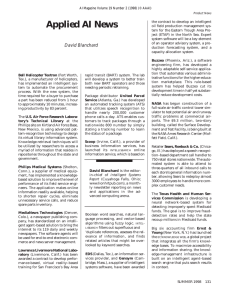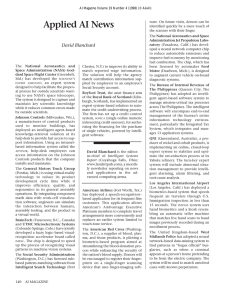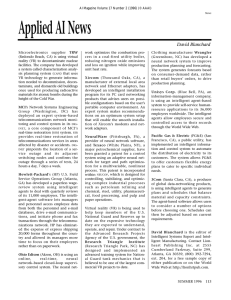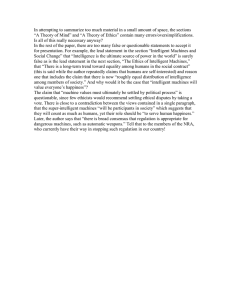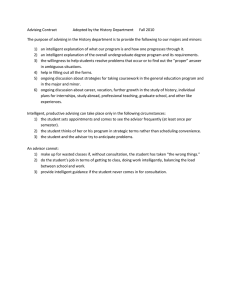Net-ID ios, involving the deployment of the Army’s vast resources.
advertisement
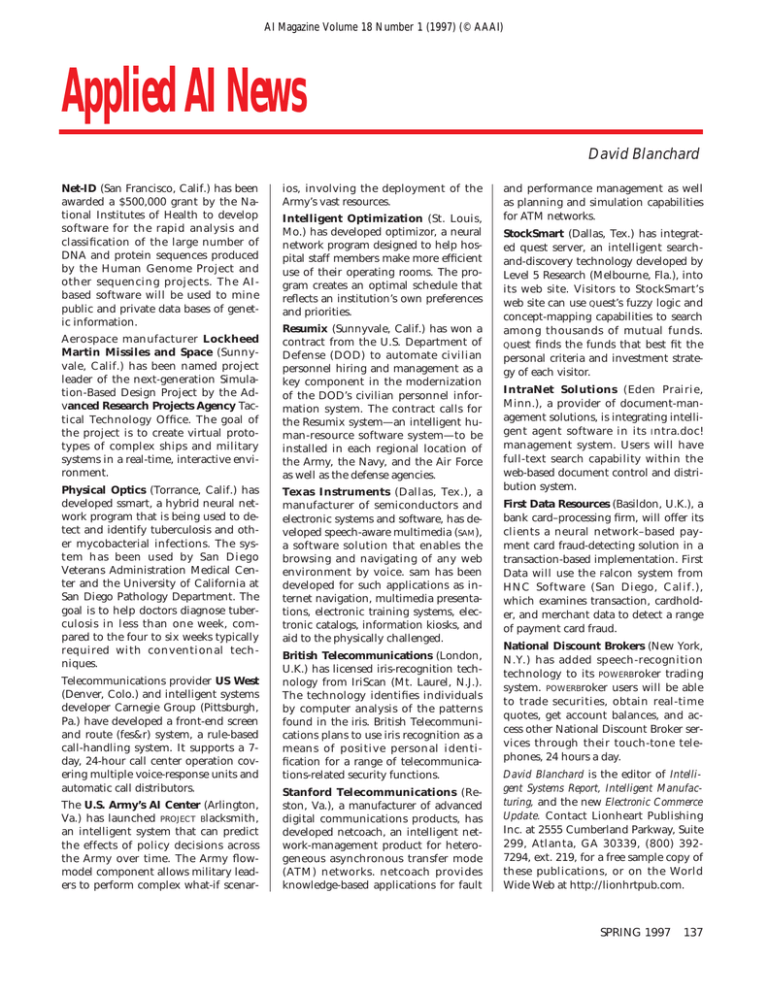
AI Magazine Volume 18 Number 1 (1997) (© AAAI) Applied AI News David Blanchard Net-ID (San Francisco, Calif.) has been awarded a $500,000 grant by the National Institutes of Health to develop software for the rapid analysis and classification of the large number of DNA and protein sequences produced by the Human Genome Project and other sequencing projects. The AIbased software will be used to mine public and private data bases of genetic information. Aerospace manufacturer Lockheed Martin Missiles and Space (Sunnyvale, Calif.) has been named project leader of the next-generation Simulation-Based Design Project by the Advanced Research Projects Agency Tactical Technology Office. The goal of the project is to create virtual prototypes of complex ships and military systems in a real-time, interactive environment. Physical Optics (Torrance, Calif.) has developed ssmart, a hybrid neural network program that is being used to detect and identify tuberculosis and other mycobacterial infections. The system has been used by San Diego Veterans Administration Medical Center and the University of California at San Diego Pathology Department. The goal is to help doctors diagnose tuberculosis in less than one week, compared to the four to six weeks typically required with conventional techniques. Telecommunications provider US West (Denver, Colo.) and intelligent systems developer Carnegie Group (Pittsburgh, Pa.) have developed a front-end screen and route (fes&r) system, a rule-based call-handling system. It supports a 7day, 24-hour call center operation covering multiple voice-response units and automatic call distributors. The U.S. Army’s AI Center (Arlington, Va.) has launched PROJECT Blacksmith, an intelligent system that can predict the effects of policy decisions across the Army over time. The Army flowmodel component allows military leaders to perform complex what-if scenar- ios, involving the deployment of the Army’s vast resources. Intelligent Optimization (St. Louis, Mo.) has developed optimizor, a neural network program designed to help hospital staff members make more efficient use of their operating rooms. The program creates an optimal schedule that reflects an institution’s own preferences and priorities. Resumix (Sunnyvale, Calif.) has won a contract from the U.S. Department of Defense (DOD) to automate civilian personnel hiring and management as a key component in the modernization of the DOD’s civilian personnel information system. The contract calls for the Resumix system—an intelligent human-resource software system—to be installed in each regional location of the Army, the Navy, and the Air Force as well as the defense agencies. Texas Instruments (Dallas, Tex.), a manufacturer of semiconductors and electronic systems and software, has developed speech-aware multimedia (SAM), a software solution that enables the browsing and navigating of any web environment by voice. sam has been developed for such applications as internet navigation, multimedia presentations, electronic training systems, electronic catalogs, information kiosks, and aid to the physically challenged. British Telecommunications (London, U.K.) has licensed iris-recognition technology from IriScan (Mt. Laurel, N.J.). The technology identifies individuals by computer analysis of the patterns found in the iris. British Telecommunications plans to use iris recognition as a means of positive personal identification for a range of telecommunications-related security functions. Stanford Telecommunications (Reston, Va.), a manufacturer of advanced digital communications products, has developed netcoach, an intelligent network-management product for heterogeneous asynchronous transfer mode (ATM) networks. netcoach provides knowledge-based applications for fault and performance management as well as planning and simulation capabilities for ATM networks. StockSmart (Dallas, Tex.) has integrated quest server, an intelligent searchand-discovery technology developed by Level 5 Research (Melbourne, Fla.), into its web site. Visitors to StockSmart’s web site can use Quest’s fuzzy logic and concept-mapping capabilities to search among thousands of mutual funds. Quest finds the funds that best fit the personal criteria and investment strategy of each visitor. IntraNet Solutions (Eden Prairie, Minn.), a provider of document-management solutions, is integrating intelligent agent software in its I ntra.doc! management system. Users will have full-text search capability within the web-based document control and distribution system. First Data Resources (Basildon, U.K.), a bank card–processing firm, will offer its clients a neural network–based payment card fraud-detecting solution in a transaction-based implementation. First Data will use the Falcon system from HNC Software (San Diego, Calif.), which examines transaction, cardholder, and merchant data to detect a range of payment card fraud. National Discount Brokers (New York, N.Y.) has added speech-recognition technology to its POWERBroker trading system. POWERBroker users will be able to trade securities, obtain real-time quotes, get account balances, and access other National Discount Broker services through their touch-tone telephones, 24 hours a day. David Blanchard is the editor of Intelligent Systems Report, Intelligent Manufacturing, and the new Electronic Commerce Update. Contact Lionheart Publishing Inc. at 2555 Cumberland Parkway, Suite 299, Atlanta, GA 30339, (800) 3927294, ext. 219, for a free sample copy of these publications, or on the World Wide Web at http://lionhrtpub.com. SPRING 1997 137
